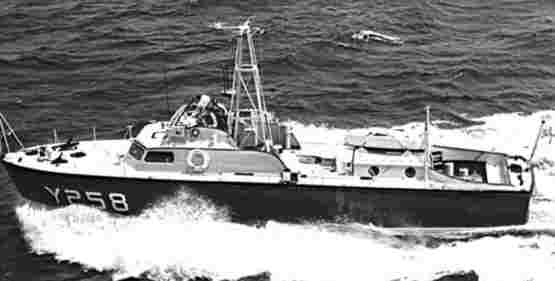- Author
- Stephen, Kerry
- Subjects
- History - post WWII
- Tags
-
- RAN Ships
- HMAS Creswell, HMAS Melbourne II, HMAS Voyager II
- Publication
- June 2009 edition of the Naval Historical Review (all rights reserved)
I took command of Air Nymph and departed the Marine Section wharf within two minutes of the alarm being sounded. Air Nymph headed to the position given for the collision, at maximum speed of 28 knots. The conditions were favourable for high speed as the wind was about Force 1 and there was a low swell of less than 1 metre. The crew prepared for the situation ahead, but as no other details had been provided about the collision, it was assumed that Melbourne and Voyager had side-swiped each other and that Air Nymph would be recalled in due course.
Shortly after the boat was underway the onboard Radio Operator, RO Les Thurgood, was directed to contact Melbourne by w/t to advise that Air Nymph was underway, with a Medical Officer on board, and ETA at the collision site was expected to be at about 2200. RO Thurgood later advised that he was unable to contact Melbourne because of the known communication atmospheric problems in the Jervis Bay area.
However, he was able to contact HMAS Parramatta who would relay the message onto Melbourne. It was later reported that Parramatta was actually in the Sunda Strait area, on deployment to the Far East, but this was never confirmed.

The second SAR, Air Sprite, was under the command of SBLT Tony Vodic and manned by the off-duty standby crew. It left the Marine Section, heading to the collision site about 10 minutes after Air Nymph.
Shortly after Air Nymph left Jervis Bay on a course of 120 degrees, a merchant ship was sighted on the Port bow at a range of about 10 miles, heading south. It was readily apparent that both ships were on a collision course, so the ship was called by Aldis light to establish its identity. No response was ever received from the bridge of the merchant ship despite the range closing rapidly and the ship’s bridge being continually flashed. The searchlight was then used but still to no avail. Notwithstanding that Air Nymph had right of way, when both vessels were about 1000 metres apart course was altered to pass close astern of the merchant ship as I seriously doubted that the merchant ship would alter course for a small vessel. The searchlight was shone on the merchant ship as Air Nymph went around the stern, and the ship’s name was seen to be Baralga.
It was of note that at the subsequent Royal Commission into the collision, the Master of the Balarga claimed he was never contacted to assist in the rescue and felt he could have been of assistance. He claimed that the only ship he had seen that night was a destroyer heading out from Jervis Bay which had passed about one mile astern of him. This was obviously Air Nymph!
The course out to the collision site was easily identified because of the number of helicopters flying overhead to assist in the rescue operations. At approximately 2155 a large number of lights were seen in the water ahead. They could not be readily identified as to what they were, so Air Nymph reduced speed to about 4 knots. When the searchlight was shone on the lights, we could see that they were from sailors in the water, some wearing lifejackets and from several life rafts. Ahead of Air Nymph a helicopter, with a searchlight underneath it, flew over the stern of the Voyager.
It then became apparent that a major catastrophe had occurred. Only the stern remained visible, with the after funnel on the waterline, and both propellers above the water. There was no sign of the forward section of the Voyager and I incorrectly assumed that it was underwater. I had not realised that Voyager had been cut in two. At this time I had not seen Melbourne as it was stopped, some 600 metres away from the stern of Voyager and where the survivors were in the water.
Many of the sailors swimming in the water were not wearing life jackets. Others wearing life jackets, could be seen close ahead of Air Nymph. Many of them could obviously see us as we approached and calls were heard from groups of those in the water saying ‘over here, over here’. Air Nymph proceeded to the nearest group of sailors in the water, and crew members then hauled them inboard over the port quarter, where the port engine had been stopped for safety reasons. Several were injured, covered in oil and obviously in shock when they were recovered, but they were extremely grateful to be in SAR. Air Nymph moved from group to group and to individuals, recovering them over the port side. During this time it was reported to me that an Air Nymph crew member jumped into the water to assist some sailors without life jackets who were in difficulties, but I was unable to establish the identity of the person concerned.




